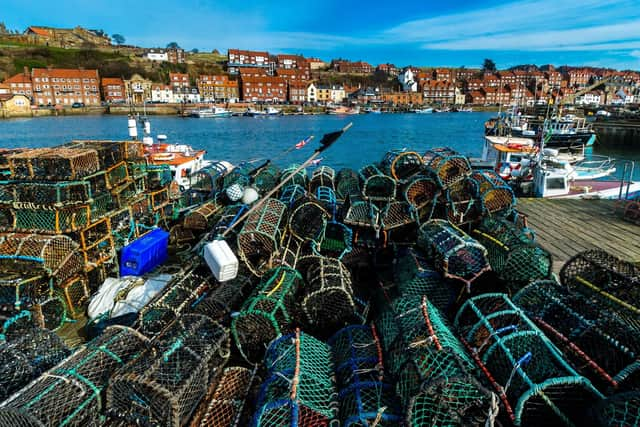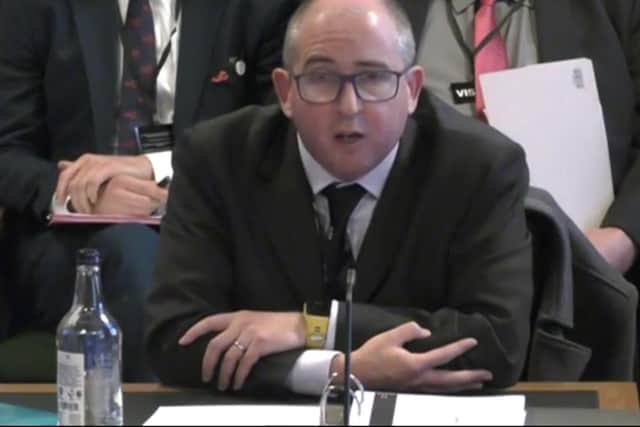MPs told ‘exceptionally toxic’ chemical may have caused crab and lobster deaths off Yorkshire coast
A Government-led investigation has concluded that a naturally-occuring algal bloom is “the most likely cause”, after the dead crustaceans began washing ashore in Yorkshire and the North East last October, and it ruled out chemical pollution.
However, Parliament’s Environment, Food and Rural Affairs Committee (EFRAC) launched an inquiry after researchers from Durham, Hull, York and Newcastle Universities published a report which cast doubt on Defra’s findings.
Advertisement
Hide AdAdvertisement
Hide AdDr Gary Caldwell, Senior Lecturer at Newcastle University's School of Natural and Environmental Sciences, told the committee that pyridine is “exceptionally toxic to crabs” and researchers have found the chemical in sediment samples taken from multiple locations along the Tees, at depths of up to 20cm.


That is a “red flag” because it implies “there is a reservoir of pyridine” deep down, he added.
Speaking at an EFRAC hearing, he said capital dredging, which is being done to pave the way for South Bank Quay, should be paused until an independently verified map of all the locations containing pyridine can be drawn up.
“For us to completely, and with confidence, say we have got a really rock-solid explanation that pyridine is the straw that broke the camel’s back in this scenario, we just need to know how much pyridine is in the deep sediment and we can’t get hold of that,” he said.
Advertisement
Hide AdAdvertisement
Hide Ad“Whatever happened, the damage is done. We can’t do anything about it.


“We can prevent any further damage from the ongoing dredging of the South Bank.”
Pyridine was found in some of the dead crabs, but Defra said it can form naturally in crustaceans after death, it did not kill them and “varying amounts” have been found in crabs in other parts of the UK.
Mark Rice, the Environment Agency’s Deputy Director for Water Quality, told MPs that pyridine was ruled out as the likely cause of the deaths, because it was not detected in the water.
Advertisement
Hide AdAdvertisement
Hide Ad"We have not detected pyridine in the River Tees since 2018 and we can detect it at extremely low levels now,” he said.
“The highest levels we’ve detected in the River Tees were back in 2012 – that was at 2.4 milligrams per litre.”
Dr Caldwell said the chemical is extremely difficult to detect in water, but it can remain stable in an oxygen-free environment like sediment buried in the river bed for years.
“Pyridine is unstable. In water it will diffuse widely, it will evaporate very quickly into the atmosphere, it will be attacked by oxygen,” he said.
Advertisement
Hide AdAdvertisement
Hide Ad“Any attempt to measure pyridine in the water is a fool’s errand unless you are on top of any kind of release.”
He also told MPs his research found a concentration of just 20 milligrams per litre caused crabs to suffer from “violent convulsions”, paralysis and then death.
“We were very much caught by surprise, we were not expecting it to be as toxic,” he said. “We were seeing crabs dying within a matter of hours.”
During the hearing, Jerry Hopkinson, Executive Chairman of PD Ports, said “relatively intense dredging” was carried out in the Tees around the time the deaths began, as around 150,000 tonnes of material was unearthed in 10 days following a “significant slippage”.
Advertisement
Hide AdAdvertisement
Hide AdBut he also said it “was not a one-off occurrence” and has been done many times over the last 50 years without any major incidents.
However, Dr Caldwell said this could be a “tangible mechanism” for inadvertently releasing large amounts of pyridine into the water.
Trudi Wakelin, Director of Licensing at the Marine Management Organisation, said material at the inner and outer dredging disposal sites was tested for pyridine last year and no concerns have been raised.
Rachel Hartnell, Science Director, Centre for Environment, Fisheries, and Aquaculture Science, told the hearing that “good evidence” suggests the deaths may have been caused by multiple algal blooms.
Advertisement
Hide AdAdvertisement
Hide AdShe said the hypothesis that one bloom “crashed” when the water temperature changed and caused an oxygen depletion, while another released the harmful toxins okadaic acid and dinophysistoxin is still being tested.
“When we get to the end of those studies, we will of course publish data, take stock and see what else we need to do,” she said.